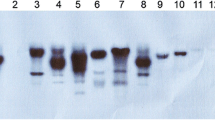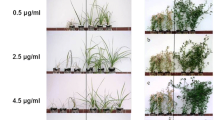Abstract
Atrazine chlorohydrolase (AtzA) catalyzes hydrolytic dechlorination and can be used in detoxification of atrazine, a herbicide widely employed in the control of broadleaf weeds. In this study, to investigate the potential use of transgenic tobacco plants for phytoremediation of atrazine, atzA genes from Pseudomonas sp. strain ADP and Arthrobacter strain AD1 were transferred into tobacco. Three and four transgenic lines, expressing atzA-ADP and atzA-AD1, respectively, were produced by Agrobacterium-mediated transformation. Molecular characterization including PCR, RT-PCR and Southern blot revealed that atzA was inserted into the tobacco genome and stably inherited by and expressed in the progenies. Seeds of the T1 transgenic lines had a higher germination percentage and longer roots than the untransformed plants in the presence of 40–150 mg/l atrazine. The T2 transgenic lines grew taller, gained more dry biomass, and had higher total chlorophyll content than the untransformed plants after growing in soil containing 1 or 2 mg/kg atrazine for 90 days. No atrazine residue remained in the soil in which the T2 transgenic lines were grown (except 401), while, in the case of the untransformed plants, 0.91 mg (81.3%) and 1.66 mg (74.1%) of the atrazine still remained in the soil containing 1 and 2 mg/kg of atrazine, respectively, indicating that the transgenic lines could degrade atrazine effectively. The transgenic tobacco lines developed could be useful for phytoremediation of atrazine-contaminated soil and water.




Similar content being viewed by others
References
Aislabie J, Bej AK, Ryburn J, Lloyd N, Lloyd N, Wilkins A (2005) Characterization of Arthrobacter nicotinovorans HIM, an atrazine-degrading bacterium, from agricultural soil New Zealand. FEMS Microbiol Ecol 52:279–286
An G, Watson BD, Chiang CC (1986) Transformation of tobacco, tomato, potato, and Arabidopsis thaliana using a binary Ti vector system. Plant Physiol 81:301–305
Anderson PC, Georgeson M (1989) Herbicide-tolerant mutants of corn. Genome 31:994–999
Atlas RM (1995) Bioremediation of petroleum pollutants. Int Biodeterior Biodegr 35:317–327
Belluck DA, Benjamin SL, Dawson T (1991) Groundwater contamination by atrazine and its metabolites: risk assessment, policy, and legal implications. In: Somasundaram L, Coats JR (eds) Pesticide transformation products: fate and significance in the environment. Washington, pp 254–273
Bouquard C, Ouazzani J, Prome J, Michel-Briand Y, Plesiat P (1997) Dechlorination of atrazine by a Rhizobium sp. isolate. Appl Environ Microb 63:862–866
Burkhand N, Guth JA (1981) Chemical hydrolysis of 2-chlor-4, 6-bis (alkylamino)-1,3,5-triazine herbicides and their breakdown in soil under the influence of adsorption. Pestic Sci 12:41–45
Clay SA, Koskinen WC (1990) Characterization of alachlor and atrazine desorption from soils. Weed Sci 38:74–80
Comber SDW (1999) Abiotic persistence of atrazine and simazine in water. Pestic Sci 55:696–702
Corbett JR (1974) The biochemical mode of pesticides. Academic Press, New York
de Souza ML, Sadowsky MJ, Wackett LP (1996) Atrazine chlorohydrolase from Pseudomonas sp. ADP: gene sequence, enzyme purification and protein characterization. J Bacteriol 178:4894–4900
Erickson EL, Lee KH (1989) Degradation of atrazine and related s-triazines. Crit Rev Env Sci Tec 19:1–14
Gammon DW, Aldous CN, Carr WC Jr, Sanborn JR, Pfeifer KF (2005) A risk assessment of atrazine use in California: human health and ecological aspects. Pest Manag Sci 61:331–355
Gavrilescu M (2005) Fate of pesticides in the environment and its bioremediation. Eng Life Sci 5:497–526
Goswami KP, Green RE (1971) Microbial degradation of the herbicide atrazine and its 2-hydroxy analog in submerged soils. Environ Sci Technol 5:426–429
Hannink N, Rosser SJ, French CE, Basran A, Murray JAH, Nicklin S, Bruce NC (2001) Phytodetoxification of TNT by transgenic plants expressing a bacterial nitroreductase. Nat Biotechnol 19:1168–1172
Höfgen R, Willmitzer L (1988) Storage of competent cells for Agrobacterium transformation. Nucleic Acids Res 16:9877
Kawahigashi H, Hirose S, Hayashi E, Ohkawa H, Ohkawa Y (2002) Phytotoxicity and metabolism of ethofumesate in transgenic rice plants expressing the human CYP2B6 gene. Pestic Biochem Phys 74:139–147
Kawahigashi H, Hirose S, Hayashi E, Ohkawa H, Ohkawa Y (2007) Herbicide resistance of transgenic rice plants expressing human CYP1A1. Biotechnol Adv 25:75–84
Li TY, Tian YC, Qin XF, Mang KQ, Li WG, He YG, Shen L (1994) Transgenic tobacco plants with efficient insect resistance. Sci China (Ser B) 37:1479–1487
Li Q, Snoeyink VL, Mariňas BJ, Campos C (2003) Pore blockage effect of NOM on atrazine adsorption kinetics of PAC: the role of PAC pore size distribution and NOM molecular weight. Water Res 37:4863–4872
Lichtenthaler H (1987) Chlorophylls and carotenoids: pigments of photosynthetic biomembranes. Method Enzymol 148:350–382
Loh JP, Kiew R, Kee A, Gan LH, Gan Y (1999) Amplified fragment length polymorphism (AFLP) provides molecular markers for the identification of Caladium bicolor cultivars. Ann Bot 84:155–161
Mandelbaum RT, Allan DL, Wackett LP (1995) Isolation and characterization of a Pseudomonas sp. that mineralizes the s-triazine herbicide atrazine. Appl Environ Microbiol 61:1451–1457
Murashige T, Skoog F (1962) A revised medium for rapid growth and bioassays with tobacco tissue cultures. Physiol Plant 15(3):473–497
Padmavathiamma KP, Li LY (2007) Phytoremediation technology: hyper-accumulation metals in plants. Water Air Soil Pollut 184:105–126
Perumbakkam S, Hess TF, Crawford RL (2006) A bioremediation approach using natural transformation in pure-culture and mixed-population biofilms. Biodegradation 17:545–557
Piutti S, Semon E, Landry D, Hartmann A, Dousset S, Lichtfouse E, Topp E, Soulas G, Martin-Laurent F (2003) Isolation and characterisation of Nocardioides sp. SP12, an atrazine-degrading bacterial strain possessing the gene trzN from bulk- and maize rhizosphere soil. FEMS Microbiol Lett 221:111–117
Rousseaux S, Hartmann A, Lagacherie B, Piutti S, Andreux F, Soulas G (2003) Inoculation of an atrazine-degrading strain, Chelatobacter heintzii Cit1, in four different soils: effects of different inoculum densities. Chemosphere 51:569–576
Sadowsky MJ, Wackett LP (2000) Genetics of atrazine and s-triazine degradation by Pseudomonas sp. Strain ADP and other bacteria. In: Hall JC, Hoagland RE, Zablotowicz RM (eds) Pesticide biotransformations in plants and microorganisms. Oxford University Press, Oxford, pp 268–282
Sambrook J, Russell D (2001) Molecular cloning: a laboratory manual, 3rd edn. Cold Spring Harbor Laboratory Press, New York
Seffernick JL, McTavish H, Osborne JP, de Souza ML, Sadowsky MJ, Wackett LP (2002) Atrazine chlorohydrolase from Pseudomonas sp. strain ADP is a metalloenzyme. Biochemistry 41:14430–14437
Shapir N, Mongodin EF, Sadowsky MJ, Daugherty SC, Nelson KE, Wackett LP (2007) Evolution of catabolic pathways: genomic insights into microbial s-triazine metabolism. J Bacteriol 189:674–682
Siripattanakul S, Wirojanagud W, McEvoy J, Limpiyakorn T, Khan E (2009) Atrazine degradation by stable mixed cultures enriched from agricultural soil and their characterization. J Appl Microbiol 106:986–992
Solomon KR, Baker DB, Richards RP, Dixon KR, Klaine SJ, La Point TW, Kendall RJ, Weisskopf CP, Giddings JM, Giesy JP, Hall LW, Williams WM (1996) Ecological risk assessment of atrazine in North American surface waters. Environ Toxicol Chem 15:31–76
Strong LC, McTavish H, Sadowsky MJ, Wackett LP (2000) Field-scale remediation of atrazine-contaminated soil using recombinant Escherichia coli expressing atrazine chlorohydrolase. Environ Microbiol 2:91–98
Struthers JK, Jayachandran K, Moorman TB (1998) Biodegradation of atrazine by Agrobacterium radiobacter J14a and use of this strain in bioremediation of contaminated soil. Appl Environ Microb 64:3365–3375
Wackett LP, Sadowsky MJ, Martinez B, Shapir N (2002a) Biodegradation of atrazine and related s-triazine compounds: from enzymes to field studies. Appl Microbiol Biotechnol 58:39–45
Wackett LP, Sadowsky MJ, Vance CP, Samac DA (2002b) Transgenic plants expressing bacterial atrazine degrading gene atzA. US Patent 6369299
Wang L, Samac DA, Shapir N, Wackett LP, Vance CP, Olszewski NE, Sadowsky MJ (2005) Biodegradation of atrazine in transgenic plants expressing a modified bacterial atrazine chlorohydrolase (atzA) gene. J Plant Biotechnol 3:475–486
Wang X, Wu N, Guo J, Chu X, Tian J, Yao B, Fan Y (2008) Phytodegradation of organophosphorus compounds by transgenic plants expressing a bacterial organ phosphorus hydrolase. Biochem Biophys Res Commun 365:453–458
Yamada T, Ohashi Y, Ohshima M, Inui H, Shiota N, Ohkawa H, Ohkawa Y (2002) Inducible cross-tolerance to herbicides in transgenic potato plants with the rat CYP1A1 gene. Theor Appl Genet 104:308–314
Acknowledgments
We thank Prof. Xiu-Qing Li (Agriculture and Agri-Food Canada Research Centre) for his helpful review of the manuscript. The research was supported by the R&D Special Projects for Public Welfare Industry of State Oceanic Administration People’s Republic of China (Grant No. 200805044) and the grant of the National Natural Science Foundation of China (No. 31070717).
Author information
Authors and Affiliations
Corresponding authors
Additional information
Communicated by P. Ozias-Akins.
Rights and permissions
About this article
Cite this article
Wang, H., Chen, X., Xing, X. et al. Transgenic tobacco plants expressing atzA exhibit resistance and strong ability to degrade atrazine. Plant Cell Rep 29, 1391–1399 (2010). https://doi.org/10.1007/s00299-010-0924-7
Received:
Revised:
Accepted:
Published:
Issue Date:
DOI: https://doi.org/10.1007/s00299-010-0924-7




